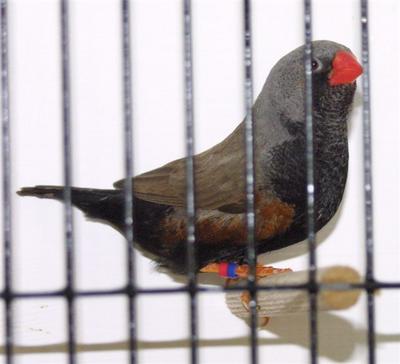

The Eumo Zebra Finch (pronounced "You-Mo" in English), has been known in Europe for quite some time but prior to this announcement it was not known to occur in the US. In the Fall of 2003 I discovered 4 Eumo Zebras in a collection of birds being sold in New Orleans Louisiana. The 4 Eumos were actually given to me as the owner thought them to "scraggly" to sell. They were 3 males and 1 female. I recognized the birds as Eumos immediately, having seen a number of photos of them and knowing of their distinct features.
Eumo Zebras are very dark birds, perhaps the blackest of all Zebra Finches. Even newly fledged chicks are exceptionally dark all over unlike any other mutation of dark zebra. Further more the Eumo has a feather abnormality, in which the barbs of the wing feathers do not interlock and the bird has a silky appearance. Consequently it has difficulty flying any distance, and can only be cage bred. Eumos cannot be kept in large flights.
Male Description: Orange cheek patch partially or wholly missing and replaced by grey, breast, belly, and vent regions solid black, with no trace of any other pigment. Tail coverts black or at least lacking some of the typical white dots, giving some individuals a completely black rump, tail and vent (a striking appearance). Flanking of male mostly devoid of spots though many will show occasional spots. (photo above are of young birds not yet in full color)
Female Description: An unusually darken female with a prominent black facial mark between the beak and the cheek patch area. Breast and belly dark grey, vent region completely black , tail coverts black as in males though some show a few spots.
Chick Description: male or female upon fledging are totally darkened as if rubbed with black charcoal soot all over. No other zebra chick looks this dark on fledging. Silky feather condition readily apparent. Here is a pict of a newly fledged baby Eumo
The Eumo very closely resembles the Australian mutation known as Charcoal, so much so that photos of the two are, in my opinion, indistinguishable. Charcoals however lack the feather abnormality and have completely normal feathers. One can only hope that in time Eumos might lose the feather problem.
I began breeding the Eumo I found to normal grey Zebras and in short order produced a number of young all carrying the gene for Eumo. In time I paired some of them to the original Eumos I discovered and once again produced a number of young. A number of these young were Eumos and it was very exciting to see them fledge and develop the characteristic and dark plumage pattern. Even the first female Eumos were dark and readily distinguished from all other zebra females. I now have 12 Eumos and a sufficient number of pairs set up to keep the production going. My goal is to make US Eumos like that pictured above, large, cobby and black. While it is a problem to deal with birds that cannot fly, I dare say the average visitor would not notice any handicap of birds kept in an average breeding cage. They fly very well across a cage. It is only in a flight that they reveal their true inability to fly.
Eumos will male a great addition to the Zebra finch community here in the US. Their exceptionally dark color I think will insure a developing interest in them despite their flying handicap.
I am producing Eumos fairly regularly and often have some available.